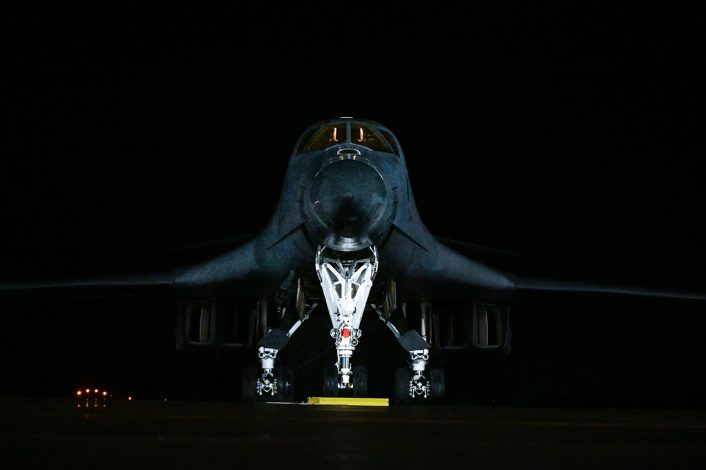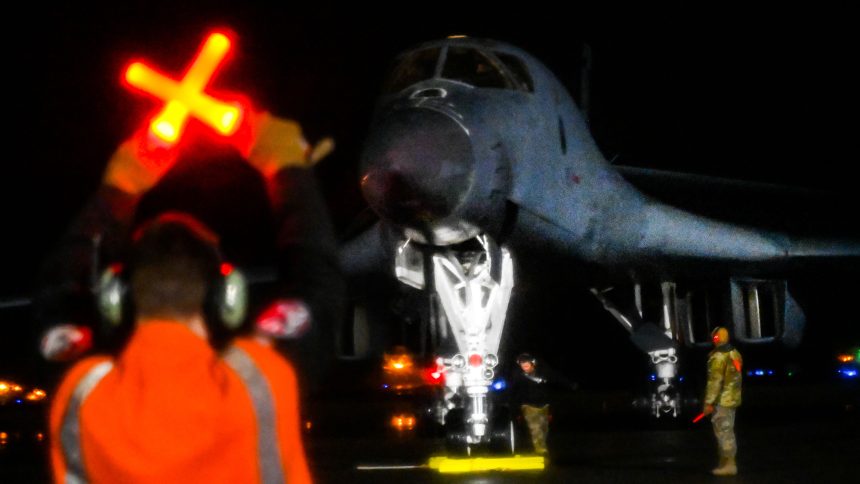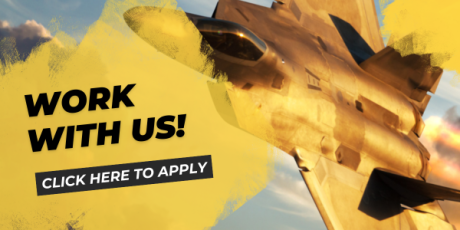Aircraft and personnel assigned to the 9th Expeditionary Bomb Squadron from Dyess AFB, Texas, landed at the base in northern Japan on Apr. 15, 2025.
A number of B-1B Lancer strategic bombers will undertake several weeks of joint training exercises and strategic deterrence missions across the Indo-Pacific. This is the first Bomber Task Force (BTF) deployment to Japan, and the first deployment of U.S. strategic bombers spanning more than several days to the nation’s territory since the Vietnam War.
Lt. Col. Christopher Travelstead, Director of Operations at the 9th EBS, said that “BTF 25-2 showcases the U.S. commitment to deterring threats and maintaining regional stability”.
The February deployment of B-52s to RAF Fairford, UK, was also designated as BTF 25-2 – after a similar multiple use of the BTF 25-1 name, it now appears that Pacific and European BTFs do not share consecutive numbering schemes. Previously, while the numbering was the same, the missions to Europe were explicitly named Bomber Task Force Europe, but since 2024 they have been referred to simply as Bomber Task Force.
“These missions in the Indo-Pacific ensure our B-1 crews are highly trained and ready to respond anytime, anywhere, to defend U.S. interests and support our allies, securing a stable Indo-Pacific—where all nations operate freely under a rules-based order while promoting global peace and prosperity,” Travelstead added.

Misawa Air Base is a vast facility located near the northern tip of Honshu, Japan’s largest island, around 425 miles north of Tokyo. The base is used both by the Japan Air Self Defense Force as well as U.S. Air Force and U.S. Navy forces. Based aircraft include two squadrons of F-16 Fighting Falcons alongside U.S. Navy P-8A Poseidons and Japanese Mitsubishi F-2s, F-35s Lightning IIs, E-2C Hawkeyes, and CH-47 Chinooks.
Two B-1B aircraft are known to have arrived so far, flying under the callsigns LOFT 11 and LOFT 12. Previous BTFs have seen initial deployments reinforced by more aircraft at later dates, so the actual number of aircraft that will be involved is unclear.
Two Dyess B-1s over Osan AB, South Korea🇰🇷, April 15th. Likely to be LOFT11 & 12 caught by TheIntelFrog in his post below [USAF Vid] https://t.co/QnRweqaveM pic.twitter.com/YrVvcMeb2g
— Saint1 (@Saint1Mil) April 15, 2025
The Bomber Task Force concept dates to a 2018 effort to develop dynamic force employment (DFE) techniques through the use of rapidly planned and executed forward deployments. The U.S. Air Force has described the practice as allowing forces to be ‘strategically predictable, but operationally unpredictable’.
However, the concept itself followed on from existing deployments made on a regular basis to locations including RAF Fairford and Andersen AFB, Guam, which now are routine hosts of BTF deployments.

While Japan hosts a vast array of permanently based U.S. military units and equipment, including the only U.S. Navy aircraft carrier to be homeported away from the United States, it has until now not hosted any of these bomber detachments. Aircraft operating on previous detachments have visited Japan briefly, and operated alongside Japanese forces, but not deployed to the country for a sustained period.
Here’s some cool Ellsworth B-1 quick hot pitting action from last week at Misawa Air Base, Japan.
I’m curious if pilots would rather stay airborne and do A2A refuel or pop down for a hot pit if they had a choice. I’d think they’d want to stay airborne as much as possible. 😎 pic.twitter.com/W1Ke8I54Ec
— Tim Farmer (@timfarmer) March 1, 2025
Although the stationing of U.S. forces in the country has long been a topic of contention in Japanese society, the Liberal Democratic Party (LDP), which has formed Japan’s government for all but six years since 1955, is strongly in favor of the continued alliance.
Regional threats from North Korea, as well as expansionist policies set forth by the current Chinese administration, have strengthened this alliance further. In 2024, it was announced that U.S. Forces Japan, the Indo-Pacific Command (INDOPACOM) subcommand that manages U.S. personnel stationed in Japan, will evolve into a Joint Force Headquarters which will have “expanded missions and operational responsibilities.”
The then U.S. Secretary of Defense Lloyd Austin said “This will be the most significant change to U.S. Forces Japan since its creation, and one of the strongest improvements in our military ties with Japan in 70 years”. No change in this policy has been set out by the new U.S. administration in this area.
Pacific Presence
The B-1B Lancers now on station in Japan add even more strength to the strategic bomber force currently deployed in the Indo-Pacific, as the surprise deployment of six B-2A Spirit stealth bombers continues in Diego Garcia.
We recently talked about reports that these B-2s have been using the unique GBU-57 Massive Ordnance Penetrator ‘bunker buster’ bomb during their confirmed operational missions over Yemen. A U.S. official, speaking to The War Zone, has now cast strong doubt on these reports, stating that: “Based on current knowledge of what munitions have been used and reports that have made it up the chain of command, my understanding is that the GBU-57 hasn’t been used during this ongoing operation”.
🇺🇸NSF Diego Garcia🇺🇸
Imagery from 17 April 2025 shows 6x KC-135 Stratotankers and 6x B-2 Bombers on the south apron of the airbase pic.twitter.com/mmcS76zxCB
— MT Anderson (@MT_Anderson) April 17, 2025
Over the coming weeks we are almost certain to see a range of operations demonstrated by these deployed B-1B Lancers, including co-operation missions with allied aircraft from Pacific nations as well as locally deployed U.S. forces, freedom of navigation operations (FONOPS) exercising the USAF’s right to operate freely in international airspace, and potentially inert or live munition drops on ranges across the region.
B-1B Lancer crews recently flew from Texas 🇺🇸 to South Korea 🇰🇷 to Japan 🇯🇵, kicking off a series of integration exercises with #AlliesAndPartners.
Our long-range bombers routinely demonstrate their lethal capability and our ironclad commitment to a #FreeAndOpenIndoPacific. pic.twitter.com/SFWE3NnqcN
— United States Strategic Command (@US_STRATCOM) April 16, 2025
In a similar practice to European BTF deployments, the B-1Bs already conducted a sortie during their arrival flight that took them over South Korea. South Korean F-16s and F-35s, as well as U.S. Air Force F-16s were also involved in this mission.









